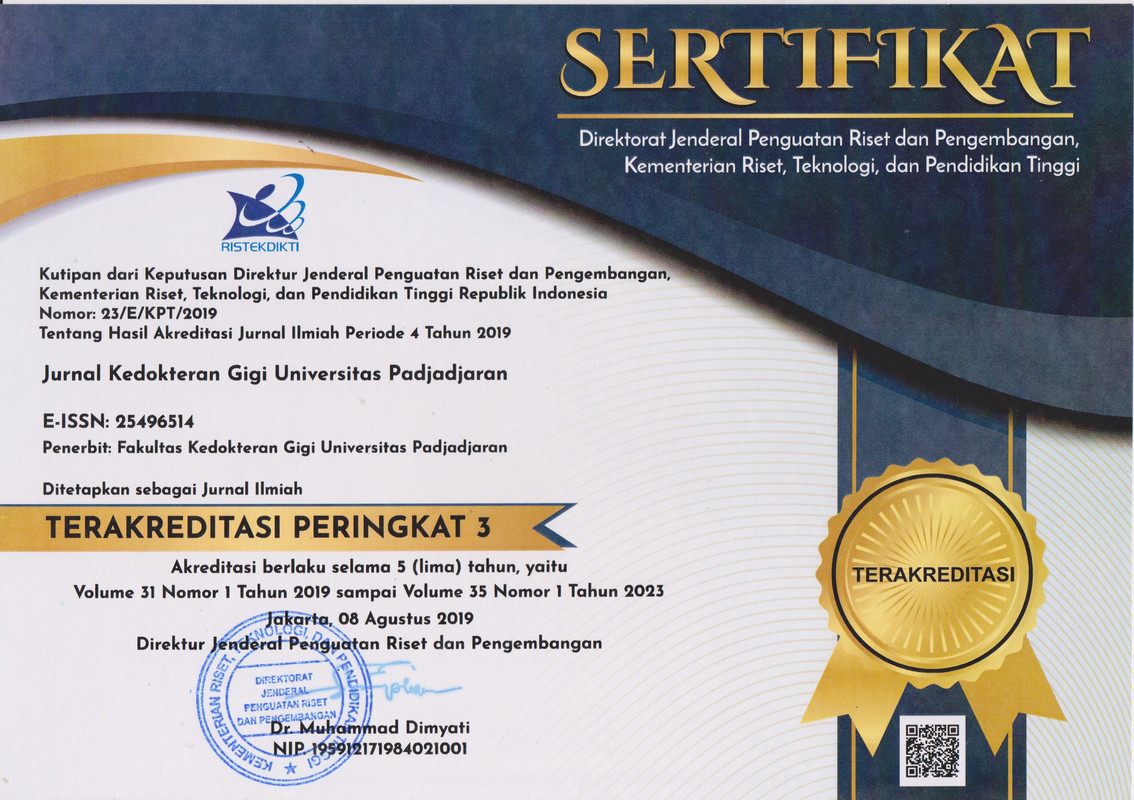Analisis kekuatan tarik denture adhesive ekstrak daun tembakau sediaan krim terhadap resin akrilik heat cured: studi eksperimental
Abstract
Tensile strength analysis of denture adhesive cream containing tobacco leaf extract on heat cured-acrylic resin: an experimental study
Introduction: Elderly patients who use complete dentures often experience adaptation difficulties. Denture adhesive creams can improve comfort; however, many commercial products contain zinc, which may promote bacterial growth in the oral cavity. Therefore, natural alternative materials are being explored. Tobacco (Nicotiana tabacum L.) contains bioactive compounds such as alkaloids and flavonoids, which have antibacterial and antimicrobial potential. Thus, tobacco (Nicotiana tabacum L.) leaf extract can be utilized as an antimicrobial ingredient in denture adhesive formulations. This study aimed to analyze the differences in tensile strength between denture adhesive creams containing 10% and 20% concentrations of tobacco leaf extract. Methods: The research was carried out in a controlled experimental laboratory setting, utilizing a post-test-only design with a control group. A total of 27 samples were divided into three groups: a control group using commercial denture adhesive, a group using 10% tobacco leaf extract adhesive, and a group using 20% tobacco leaf extract adhesive. All samples were immersed in artificial saliva for 60 seconds before tensile strength testing using a Universal Testing Machine. Data were analyzed using the Shapiro-Wilk test for normality, the Levene-test homogeneity, followed by the Kruskal-Wallis and Mann-Whitney tests. Results: The 10% tobacco leaf extract denture adhesive exhibited a higher tensile strength value compared to the 20% extract formulation. A significant difference (p<0.05) was found between the 10% and 20% concentrations of tobacco leaf extract and the commercial denture adhesive. Conclusion: Denture adhesives containing 10% and 20% tobacco leaf extract (Nicotiana tabacum L.) both demonstrated good tensile strength, with 10% concentration showing superior tensile strength compared to the 20% formulation.
Keywords
Full Text:
PDFReferences
Fadriyanti O, Alamsyah Y, Rabianti D. Evaluasi pemakaian denture adhesive pada gigi tiruan lengkap resin akrilik: scoping review. Menara Ilmu. 2022;16(2):55-62. https://doi.org/10.31869/mi.v16i2.3289
Fathonah DT, Mustiko H, Indrastuti DM. Pengaruh lama adaptasi bicara pemakai gigi tiruan lengkap resin akrilik terhadap kualitas suara pengucapan huruf /s/ (observasi klinis). J Ked Gi. 2015;6(3):271-7.
Varghese R, Burnett GR, Souverain A, Patil A, Gossweiler AG. A randomised bite force study assessing two currently marketed denture adhesive products compared with no-adhesive control. Clin Exp Dent Res 2019;5:276-83. https://doi.org/10.1002/cre2.182
Fallahi A, Khadivi N, Roohpour N, Middleton AM, Kazemzadeh-Narbat M, Annabi N, et al. Characterization, mechanistic analysis and improving the properties of denture adhesive. J Dent Mater. 2019;34(1):120-31. https://doi.org/10.1016/j.dental.2017.09.015
Cordaro M, Donno S, Ausenda F, Cordaro L. Influence of bone anatomy on implant placement procedures in edentulous arches of elderly individuals: a cross-sectional study on computed tomography images. Int J Oral Maxillofac Implants. 2020;35:995-1004.3 https://doi.org/10.11607/jomi.8297
Bogucki ZA, Napadlek P, Dabrowa T. A clinical evaluation denture adhesives used by patients with xerostomia. J Med (United States). 2015;94(7):e545. https://doi.org/10.1097/MD.0000000000000545
Papadiochous, EmmanouilI,Papadiochos I. Denture adhesives:A systematic review. J Prosthet Dent. 2015;113:391-397. https://doi.org/10.1016/j.prosdent.2014.11.001
Gill SK, Roohpour N, Topham PD, Tighe BJ. Tunable Denture Adhesives Using Biomimetic Principles for Enhanced Aissue adhesion in Moist Environments. Acta Bio Material. 2017;63:326-35. https://doi.org/10.1016/j.actbio.2017.09.004
Kurogi T, Murata H, Yamaguchi E, Kawai Y, Suzuki A, Koide Y, et al. Effects of denture adhesives on denture retention and occlusal forces in complete denture wearers: A multicenter, randomized controlled trial. J Prosthodont Res. 2023;67(4):548-55. https://doi.org/10.2186/jpr.JPR_D_22_00178
Alhusna H, Dallmer A. Pengaruh penggunaan denture adhesive sediaan powder dan denture adhesive sediaan cream terhadap kekuatan retensi pada pemakai gigi tiruan lengkap. J Ked Gi Univ Padj. 2020;32(1):72. https://doi.org/10.24198/jkg.v32i1.25541
Kumar PR, Shajahan PA, Mathew J, Koruthu A, Aravind P, Ahammed MF. Denture adhesives in prosthodontics: an overview. J Int oral Heal JIOH. 2015;7(Suppl 1):93-5. PMC4516076
Yamaguchi K, Hama Y, Soeda H, Hatano K, Okada M, Futatsuya R, et al. Factors associated with selection of denture adhesive type: a cross-sectional survey. J Clin Med. 2023;12(3): 1-9. https://doi.org/10.3390/jcm12030873
Harlianingtyas I, Triwidiarto C, Kusuma SI, 'Azizah M. Pengaruh iklim terhadap produksi tembakau di kabupaten Jember. J Ilm Inov. 2021;21(2):86-94. https://doi.org/10.25047/jii.v21i2.2615
Patricia VM. Potensi tanaman tembakau (nicotiana tabacum l.) sebagai salah satu diversifikasi produk di bidang farmasi. J Bunga Rampai (b Chapter) Progr Stud Farm. 2022;2(1):36-45.
Kristiana D, Soesetijo A, Gunadi A, Parnaadji R, Naini A. Effervescent tablets of tobacco leaves (nicotiana tabacum l.) potential as denture cleansers. J Dentomaxillofac Sci. 2022;7(1):102-8. https://doi.org/10.15562/jdmfs.v7i2.1383
Kristiana D, Soesetijo A, Gunadi A, Parnaadji R, Naini A, Dwiatmoko S, et al. The effectiveness of tobacco leaf effervescent tablets (nicotiana tabacum l.) 75% against surface roughness and acrylic color change. J Int Dent Med Res. 2022;15(2):490-7.
Adusumilli PS, Gandhi AS, Kulkarni SA, Lambert MA, Roohpour N. Denture adhesive: the invention relates to denture adhesive and methods for making denture adhesive. International Application Published Under The Patent Cooperative Treaty (PCT). International Publication Number WO/2016/062624 A1. International Patent Classification A16K 6/00 (2006.01). 2016. p. 1-19.
Fadriyanti O. Analisis Ekstrak aspergillus sp. dalam Denture Adhesive terhadap Kekuatan Transversa Resin Akrilik dengan Virulensi Candida albicans. B-Dent: Jurnal Kedokteran Gigi Universitas Baiturrahmah. 2022;9(2):167–76.
Bogucki ZA. Denture adhesives' effect on retention of prostheses in patients with xerostomia. Adv Clin Exp Med 2018;27:1247-52. https://doi.org/10.17219/acem/69078
Yegin E, Akpinar YZ, Yavuz T, Aslan MA. Effect of different denture adhesives on retention of complete dentures: an in vivo study. J Adhesion Scie Techno. 2017;31(18):2044–2052. https://doi.org/10.1080/01694243.2017.1296652
De Oliveira SGD. A new method for evaluating the retentive efficacy of different denture adhesive. J Wind Eng Ind Aerodyn. 2019;26(1):1-4.
Nakai K, Maeda T, Hong G, Kurogi T, Okazaki J. Effects of herbal medicine components on the physical properties of trial denture adhesives. Dental J. 2017 Dec 30;50(4):171. https://doi.org/10.20473/j.djmkg.v50.i4.p171-177
Mekkawy M, Samy O, Alruhaimi R. The effect of herbal denture adhesive on patient satisfaction in comparison to traditional type. J Cureus. 2023;15(9):1-11. https://doi.org/10.7759/cureus.46001
DOI: https://doi.org/10.24198/jkg.v37i2.61127
Refbacks
- There are currently no refbacks.
Copyright (c) 2025 Jurnal Kedokteran Gigi Universitas Padjadjaran
INDEXING & PARTNERSHIP

Jurnal Kedokteran Gigi Universitas Padjadjaran dilisensikan di bawah Creative Commons Attribution 4.0 International License






.png)

















